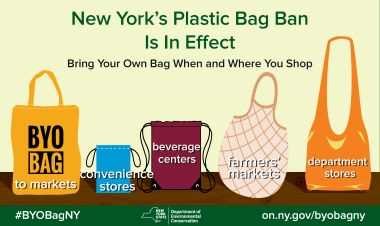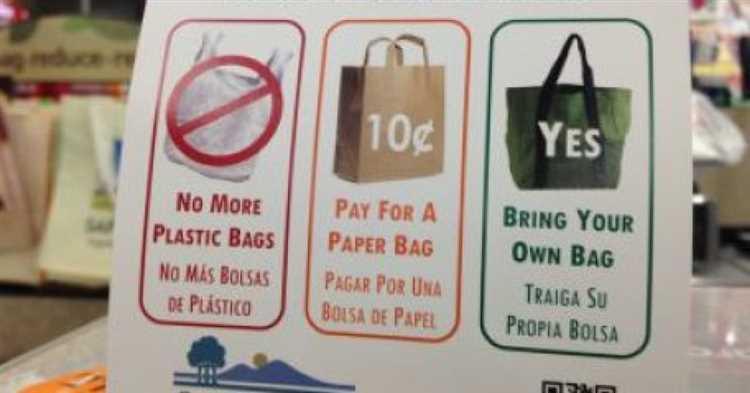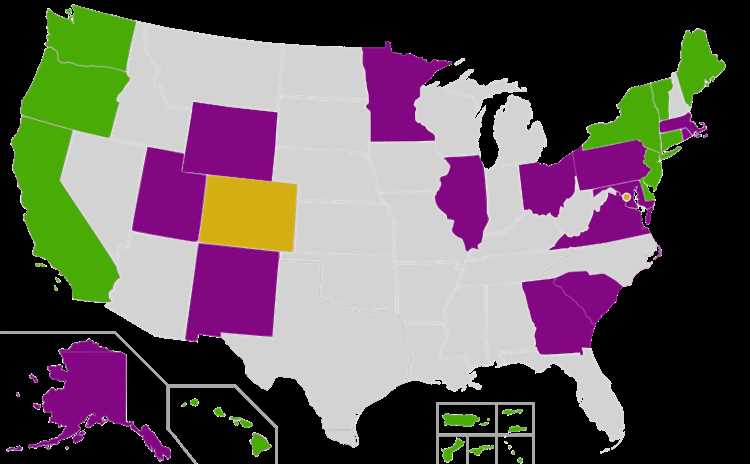
In an effort to reduce waste and promote eco-friendly practices, many states in the United States have implemented regulations regarding the use of plastic and paper bags at retail stores. These regulations often include fees for using such bags, encouraging consumers to bring their own reusable bags instead. The idea behind these fees is to incentivize individuals to make more sustainable choices and decrease the environmental impact of single-use bags.
California was the first state to introduce a statewide ban on single-use plastic bags in 2014. The ban initially faced opposition from the plastics industry, but it has since been successful in reducing plastic bag consumption and promoting the use of reusable bags. California law also requires stores to charge a minimum of 10 cents for each paper bag provided to customers.
Oregon followed suit and implemented a similar statewide ban on single-use plastic bags in 2020. The ban applies to all retail stores and requires customers to bring their own bags or pay a fee for each paper bag provided by the store. The fee can range from 5 to 25 cents per bag, depending on the location.
In addition to California and Oregon, several other states have also implemented bag regulations. These include Connecticut, Delaware, Hawaii, Maine, New York, and Vermont. Each state has its own specific requirements and fees, but the overall goal remains the same – to reduce waste and promote the use of reusable bags.
- Overview of Bag Payment Regulations
- Advantages of Bag Payment Programs
- 1. Encourages the use of reusable bags
- 2. Reduces litter and waste
- Disadvantages of Bag Payment Programs
- 1. Increased cost for consumers
- 2. Inconvenience for shoppers
- 3. Limited effectiveness
- States with Bag Payment Laws
- Impact of Bag Payment Laws on the Environment
- Question-answer:,
- Why do some states require payment for bags?
- Which states in the United States require payment for bags?
- How much is the typical charge for bags in states that require payment?
- What happens if someone does not pay for a bag in a state that requires payment?
- Are there any exemptions or discounts for bags in states that require payment?
- What is the purpose of the article “Which States Require Payment for Bags?”?
Overview of Bag Payment Regulations
Bag payment regulations are in effect in several states across the United States. These regulations aim to reduce waste and encourage the use of reusable bags. Under these regulations, customers are required to pay for each bag they use while shopping.
The exact payment amount and method vary by state. Some states charge a fixed fee per bag, while others calculate the fee based on bag size or type. Additionally, some states allow retailers to determine the payment amount, as long as it is reasonable and collected from customers.
The implementation of bag payment regulations has had a positive impact on the environment. By discouraging single-use bags, these regulations help to reduce plastic waste and protect natural resources. They also encourage consumers to switch to reusable bags, which can be used multiple times, thus reducing waste even further.
It is important for consumers to be aware of bag payment regulations in their state and plan accordingly. By being mindful of these regulations, individuals can make informed choices and contribute to a more sustainable future.
Advantages of Bag Payment Programs
Bag payment programs, which require customers to pay for bags at the checkout, have several advantages for both consumers and the environment.
1. Encourages the use of reusable bags
By implementing bag payment programs, states can promote the use of reusable bags instead of single-use plastic bags. This helps to reduce the consumption of plastic and the associated environmental problems. Reusable bags are more durable and can be used multiple times, making them a more sustainable choice.
2. Reduces litter and waste

When customers have to pay for bags, they are more likely to bring their own bags or use fewer bags altogether. This reduces the amount of waste generated and helps to minimize litter in communities. With fewer plastic bags ending up in landfills or polluting waterways, bag payment programs contribute towards a cleaner and healthier environment.
Strong participation in bag payment programs can lead to a significant reduction in the use of single-use plastic bags, leading to long-term environmental benefits.
Overall, bag payment programs have advantages for both individuals and the planet. They encourage the use of reusable bags, reduce litter and waste, and contribute to a more sustainable future. By implementing these programs, states can take an important step towards reducing plastic consumption and protecting the environment.
Disadvantages of Bag Payment Programs
While bag payment programs have gained popularity in several states as a means to reduce waste and promote sustainability, they also have some disadvantages that need to be considered.
1. Increased cost for consumers

One of the main criticisms of bag payment programs is that they place an additional financial burden on consumers. While the cost of a single bag may seem negligible, it can quickly add up, especially for individuals or families who rely on multiple bags for their shopping needs. This can disproportionately affect low-income households, who may struggle to afford the extra expense.
2. Inconvenience for shoppers
Paying for bags can also be seen as an inconvenience for shoppers. It adds an extra step to the process of getting groceries or other items, as well as the need to remember to bring reusable bags with them. This can lead to frustration and dissatisfaction, especially for those who are used to the convenience of free bags.
Furthermore, bag payment programs can disrupt established routines and increase the time it takes to complete a shopping trip.
3. Limited effectiveness
While bag payment programs aim to reduce waste and promote the use of reusable bags, their effectiveness in achieving these goals is limited. Some studies have found that the reduction in single-use bags is offset by an increase in the use of alternative disposable bags, such as thicker plastic bags or paper bags.
Moreover, bag payment programs may not address the root causes of waste or encourage long-term behavior change. They may simply shift the burden from one type of bag to another without significantly reducing overall waste.
Overall, bag payment programs have their drawbacks, and it is important to carefully consider their implications before implementing them on a wider scale.
States with Bag Payment Laws
Several states in the United States have implemented bag payment laws to reduce the use of single-use plastic bags and encourage the use of reusable bags. These laws require retailers to charge customers a fee for each single-use bag they request.
California: California was the first state to pass a bag payment law in 2014. The law initially required retailers to charge customers $0.10 for each single-use bag. In 2016, the law was expanded to include all types of retail stores, not just grocery stores.
Hawaii: In 2015, Hawaii became the second state to implement a bag payment law. The law requires retailers to charge customers $0.15 for each single-use bag.
Oregon: Oregon followed suit in 2019 with its own bag payment law. Retailers in the state must charge customers $0.05 for each single-use bag.
New York: In 2020, New York joined the ranks of states with bag payment laws. Retailers in New York City must charge customers $0.05 for each single-use bag, while the rest of the state charges $0.10 per bag.
Connecticut: Connecticut implemented its bag payment law in 2021, requiring retailers to charge customers $0.10 for each single-use bag.
Delaware: Delaware has also passed a bag payment law, but it has not yet gone into effect. Once implemented, retailers will charge customers $0.10 for each single-use bag.
Other states, such as Maine, Vermont, and Washington, D.C., have also passed bag payment laws that will go into effect in the near future.
These bag payment laws aim to reduce plastic waste, promote sustainability, and encourage consumers to bring their own reusable bags when shopping. By implementing these laws, states hope to make a positive impact on the environment and reduce the need for single-use plastic bags.
Impact of Bag Payment Laws on the Environment
Bag payment laws, also known as bag fees or bag taxes, have been implemented in several states as a measure to reduce the use of plastic bags and promote environmental sustainability. These laws require customers to pay a small fee for each disposable bag they use when shopping.
- Reduction in plastic bag usage: One of the key impacts of bag payment laws is the significant reduction in plastic bag usage. By imposing a fee, customers are incentivized to bring their own reusable bags or use fewer bags overall. This helps to reduce the overall consumption of single-use plastic bags, which are known to have a detrimental impact on the environment.
- Decreased litter: Payment for bags has also shown to be effective in reducing litter. With fewer disposable bags being used, there are fewer bags ending up in the environment as litter. This helps to prevent plastic pollution in our streets, parks, and waterways.
- Protection of wildlife: Plastic bags pose a significant threat to wildlife, particularly marine life. They can be mistaken for food by animals, leading to ingestion and potential harm or death. By reducing plastic bag usage through bag payment laws, we can help protect wildlife and their habitats.
- Conservation of natural resources: Plastic bags are made from non-renewable resources such as petroleum. By reducing the demand for plastic bags, bag payment laws contribute to the conservation of these valuable resources. This helps to minimize the environmental impact associated with extracting and processing these resources.
- Promotion of reusable alternatives: Bag payment laws encourage the use of reusable bags. Reusable bags are typically made from durable materials such as cloth or recycled materials, and can be used multiple times. By promoting the use of reusable bags, bag payment laws encourage a shift towards more sustainable shopping habits.
Overall, bag payment laws have a positive impact on the environment by reducing plastic bag usage, decreasing litter, protecting wildlife, conserving natural resources, and promoting the use of reusable alternatives. These laws play an important role in promoting environmental sustainability and creating a cleaner, healthier planet for future generations.
Question-answer:,
Why do some states require payment for bags?
Some states require payment for bags in an effort to reduce plastic waste and encourage consumers to use reusable bags. By charging for bags, it serves as a deterrent and encourages individuals to bring their own bags while shopping.
Which states in the United States require payment for bags?
As of now, there are eight states in the United States that require payment for bags. These states include California, Connecticut, Delaware, Hawaii, Maine, New York, Oregon, and Vermont.
How much is the typical charge for bags in states that require payment?
The charge for bags in states that require payment varies. In California, the typical charge is $0.10 per bag, while in Connecticut, it is $0.10 per bag as well. In New York, the charge is $0.05 per bag. The amount may differ slightly in each state.
What happens if someone does not pay for a bag in a state that requires payment?
If someone does not pay for a bag in a state that requires payment, they may be subject to a fine or penalty. The specific consequences vary depending on the state. It is important to comply with the bag payment regulations to avoid any potential penalties.
Are there any exemptions or discounts for bags in states that require payment?
Some states may have exemptions or discounts for certain types of bags. For example, in California, certain bags used for things like meat, produce, or prescriptions are exempt from the payment requirement. Additionally, some states may offer discounted bag prices for individuals with lower income or participants in assistance programs.
What is the purpose of the article “Which States Require Payment for Bags?”?
The purpose of the article is to inform readers about which states in the United States require payment for bags at retail stores.